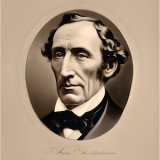The Neighbouring Families Page #2
The Neighbouring Families is a delightful collection of fairy tales by Hans Christian Andersen. The book explores themes of friendship, love, and the significant impact of societal and familiar relations on individual lives, presented through enchanting narratives starring both humans and fantastical creatures living in harmony. The stories in this book are tinged with humor, wit, and classic Andersonian wisdom that amuse as well as provoke deeper reflection.
horse-hair was drawn tightly round her leg--as tightly as if the latter were to be cut off; she was in great pain and terror. The boys came running up and seized her, and in no gentle way either. "It's only a sparrow," they said; they did not, however, let her go, but took her home with them, and every time she cried they hit her on the beak. In the farmhouse was an old man who understood making soap into cakes and balls, both for shaving and washing. He was a merry old man, always wandering about. On seeing the sparrow which the boys had brought, and which they said they did not want, he asked, "Shall we make it look very pretty?" At these words an icy shudder ran through the sparrow-mother. Out of his box, in which were the most beautiful colours, the old man took a quantity of shining leaf-gold, while the boys had to go and fetch some white of egg, with which the sparrow was to be smeared all over; the gold was stuck on to this, and the sparrow-mother was now gilded all over. But she, trembling in every limb, did not think of the adornment. Then the soap-man tore off a small piece from the red lining of his old jacket, and cutting it so as to make it look like a cock's comb, he stuck it to the bird's head. "Now you will see the gold-jacket fly," said the old man, letting the sparrow go, which flew away in deadly fear, with the sun shining upon her. How she glittered! All the sparrows, and even a crow--and an old boy he was too--were startled at the sight; but still they flew after her to learn what kind of strange bird she was. Driven by fear and horror, she flew homeward; she was almost sinking fainting to the earth, while the flock of pursuing birds increased, some even attempting to peck at her. "Look at her! Look at her!" they all cried. "Look at her! Look at her" cried her little ones, as she approached the nest. "That is certainly a young peacock, for it glitters in all colours; it makes one's eyes ache, as mother told us. Peep! that's 'the beautiful'." And then they pecked at the bird with their little beaks so that it was impossible for her to get into the nest; she was so exhausted that she couldn't even say "Peep!" much less "I am your own mother!" The other birds, too, now fell upon the sparrow and plucked off feather after feather until she fell bleeding into the rose-bush. "Poor creature!" said all the roses; "only be still, and we will hide you. Lean your little head against us." The sparrow spread out her wings once more, then drew them closely to her, and lay dead near the neighbouring family, the beautiful fresh roses. "Peep!" sounded from the nest. "Where can mother be so long? It's more than I can understand. It cannot be a trick of hers, and mean that we are now to take care of ourselves. She has left us the house as an inheritance; but to which of us is it to belong when we have families of our own?" "Yes, it won't do for you to stay with me when I increase my household with a wife and children,"' said the smallest. "I daresay I shall have more wives and children than you," said the second. "But I am the eldest!" exclaimed the third. Then they all got excited; they hit out with their wings, pecked with their beaks, and flop! one after another was thrown out of the nest. There they lay with their anger, holding their heads on one side and blinking the eye that was turned upwards. That was their way of looking foolish. They could fly a little; by practice they learned to improve, and at last they agreed upon a sign by which to recognise each other if they should meet in the world later on. It was to be one "Peep!" and three scratches on the ground with the left foot. The young one who had remained behind in the nest made himself as broad as he could, for he was the proprietor. But this greatness did not last long. In the night the red flames burst through the window and seized the roof, the dry straw blazed up high, and the whole house, together with the young sparrow, was burned. The two others, who wanted to marry, thus saved their lives by a stroke of luck. When the sun rose again and everything looked as refreshed as if it had had a quiet sleep, there only remained of the farmhouse a few black charred beams leaning against the chimney, which was now its own master. Thick smoke still rose from the ruins, but the rose-bush stood yonder, fresh, blooming, and untouched, every flower and every twig being reflected in the clear water. "How beautifully the roses bloom before the ruined house," exclaimed a passer-by. "A pleasanter picture cannot be imagined. I must have that." And the man took out of his portfolio a little book with white leaves: he was a painter, and with his pencil he drew the smoking house, the charred beams and the overhanging chimney, which bent more and more; in the foreground he put the large, blooming rose-bush, which presented a charming view. For its sake alone the whole picture had been drawn. Later in the day the two sparrows who had been born there came by. "Where is the house?" they asked. "Where is the nest? Peep! All is burned and our strong brother too. That's what he has now for keeping the nest. The roses got off very well; there they still stand with their red cheeks. They certainly do not mourn at their neighbours' misfortunes. I don't want to talk to them, and it looks miserable here--that's my opinion." And away they went. On a beautiful sunny autumn day--one could almost have believed it was still the middle of summer--there hopped about in the dry clean-swept courtyard before the principal entrance of the Hall a number of black, white, and gaily-coloured pigeons, all shining in the sunlight. The pigeon-mothers said to their young ones: "Stand in groups, stand in groups! for that looks much better." "What kind of creatures are those little grey ones that run about behind us?" asked an old pigeon, with red and green in her eyes. "Little grey ones! Little grey ones!" she cried. "They are sparrows, and good creatures. We have always had the reputation of being pious, so we will allow them to pick up the corn with us; they don't interrupt our talk, and they scrape so prettily when they bow." Indeed they were continually making three foot-scrapings with the left foot and also said "Peep!" By this means they recognised each other, for they were the sparrows from the nest on the burned house. "Here is excellent fare!" said the sparrow. The pigeons strutted round one another, puffed out their chests mightily, and had their own private views and opinions. "Do you see that pouter pigeon?" said one to the other. "Do you see how she swallows the peas? She eats too many, and the best ones too. Curoo! Curoo! How she lifts her crest, the ugly, spiteful creature! Curoo! Curoo!" And the eyes of all sparkled with malice. "Stand in groups! Stand in groups! Little grey ones, little grey ones! Curoo, curoo, curoo!" So their chatter ran on, and so it will run on for thousands of years. The sparrows ate lustily; they listened attentively, and even
Translation
Translate and read this book in other languages:
Select another language:
- - Select -
- 简体中文 (Chinese - Simplified)
- 繁體中文 (Chinese - Traditional)
- Español (Spanish)
- Esperanto (Esperanto)
- 日本語 (Japanese)
- Português (Portuguese)
- Deutsch (German)
- العربية (Arabic)
- Français (French)
- Русский (Russian)
- ಕನ್ನಡ (Kannada)
- 한국어 (Korean)
- עברית (Hebrew)
- Gaeilge (Irish)
- Українська (Ukrainian)
- اردو (Urdu)
- Magyar (Hungarian)
- मानक हिन्दी (Hindi)
- Indonesia (Indonesian)
- Italiano (Italian)
- தமிழ் (Tamil)
- Türkçe (Turkish)
- తెలుగు (Telugu)
- ภาษาไทย (Thai)
- Tiếng Việt (Vietnamese)
- Čeština (Czech)
- Polski (Polish)
- Bahasa Indonesia (Indonesian)
- Românește (Romanian)
- Nederlands (Dutch)
- Ελληνικά (Greek)
- Latinum (Latin)
- Svenska (Swedish)
- Dansk (Danish)
- Suomi (Finnish)
- فارسی (Persian)
- ייִדיש (Yiddish)
- հայերեն (Armenian)
- Norsk (Norwegian)
- English (English)
Citation
Use the citation below to add this book to your bibliography:
Style:MLAChicagoAPA
"The Neighbouring Families Books." Literature.com. STANDS4 LLC, 2025. Web. 22 Jan. 2025. <https://www.literature.com/book/the_neighbouring_families_2198>.




Discuss this The Neighbouring Families book with the community:
Report Comment
We're doing our best to make sure our content is useful, accurate and safe.
If by any chance you spot an inappropriate comment while navigating through our website please use this form to let us know, and we'll take care of it shortly.
Attachment
You need to be logged in to favorite.
Log In